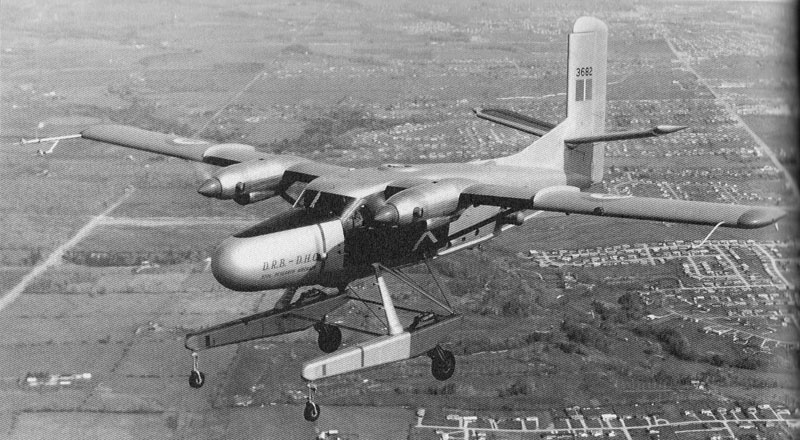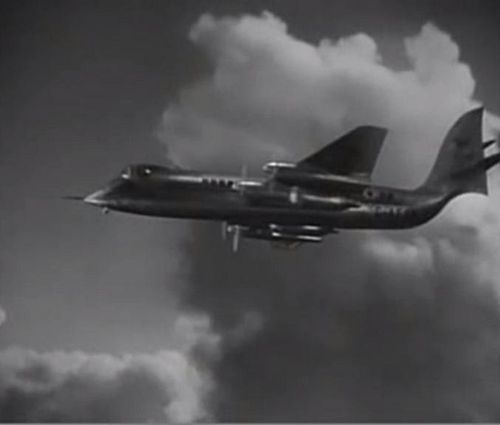Otter..whats the story..
Thread Starter
Join Date: Aug 2009
Location: uk
Posts: 370
Likes: 0
Received 0 Likes
on
0 Posts
Short take-off and landing Otter, the final version in this development was fitted with a sturdy four-wheel undercarriage, a larger vertical tail unit, Bat-wing flaps (as seen in the shot above) and a turbine engine in the fuselage with movable nozzles on the fuselage sides which deflected the exhaust forward and down.
Have a look at this book for more about it:
Have a look at this book for more about it:
It's been a while since I read the book but I managed to find it pretty quickly, apologies for a sloppy scanning job. Otters 3674 and 3682 were used to develop a shorter landing Otter with the aim of crossing a 50 foot obstacle and landing in less than 500 feet. They reached a figure of 362 feet after the obstacle with the phase two aircraft. In the end severe structural problems due to sonic fatigue inside the fin ended the program and the aircraft was scrapped.

Ground effect testing on Otter 3674 in 1957. Tufting installed to show airflow, fully deployed batwing flaps and engine running to blow flight surfaces.

Phase one Otter 3682 with bat flaps operated by external actuators low on the fuselage, drooped leading edge and new tail and landing gear, summer 1959.

Phase two Otter 3682 on final approach with J-85 modulated valves supplying reverse thrust through forward slot, enabling the X-Otter to descend nearly vertically.

Officially this was the DRB-DHC STOL Research aircraft twin.
In its phase three configuration the Otter sported the reverse thrust J-85 (note intake between wing trailing edges) and twin PT-6 turboprops replacing the nose-mounted R-1340 radial piston engine, seen here in 1964.
(All photos and info from the book I linked to in a previous post.)

Ground effect testing on Otter 3674 in 1957. Tufting installed to show airflow, fully deployed batwing flaps and engine running to blow flight surfaces.

Phase one Otter 3682 with bat flaps operated by external actuators low on the fuselage, drooped leading edge and new tail and landing gear, summer 1959.

Phase two Otter 3682 on final approach with J-85 modulated valves supplying reverse thrust through forward slot, enabling the X-Otter to descend nearly vertically.

Officially this was the DRB-DHC STOL Research aircraft twin.
In its phase three configuration the Otter sported the reverse thrust J-85 (note intake between wing trailing edges) and twin PT-6 turboprops replacing the nose-mounted R-1340 radial piston engine, seen here in 1964.
(All photos and info from the book I linked to in a previous post.)
Have Helicopters EVER been proven and successful?
But, seriously, a fixed wing aircraft will always be more economical than a chopper- you only use a Helicopter when the task simply CANNOT be achieved by a fixed wing.
But, seriously, a fixed wing aircraft will always be more economical than a chopper- you only use a Helicopter when the task simply CANNOT be achieved by a fixed wing.
Last edited by Wizofoz; 23rd Apr 2013 at 10:33.
Ich bin ein Prooner.
Join Date: Feb 2003
Location: Home of the Full Monty.
Posts: 511
Likes: 0
Received 0 Likes
on
0 Posts
It looks as though it was designed by the same bloke who designed the Rutland Reindeer!


Last edited by Noah Zark.; 23rd Apr 2013 at 20:50.
What's the story on that bizarre undercarriage?
Ground effect testing on Otter 3674 in 1957. Tufting installed to show airflow, fully deployed batwing flaps and engine running to blow flight surfaces.
Either way, it clearly isn't expected to leave the ground trailing all that ironmongery.

Join Date: Sep 2008
Location: Cornwall UK
Age: 79
Posts: 507
Likes: 0
Received 0 Likes
on
0 Posts
Originally Posted by Agaricus bisporus
What's the story on that bizarre undercarriage?
Originally Posted by DaveReidUK
It's not clear whether the rig is intended to be towed, or whether it's just the prop that's providing the airflow to energise the lifting surfaces.
Last edited by Jhieminga; 24th Apr 2013 at 21:30.
The data obtained during testing of the DRB-DHC STOL Research aircraft twin (1964 photo in post 4) was used in the design of the Twin Otter, which was launched in 1964. I'm glad DHC got rid of that ugly fin, though!
Last edited by India Four Two; 28th Apr 2013 at 06:53.







